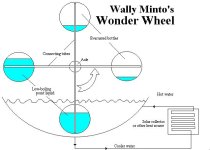Branch
Silver Member
Something I saw awhile back might fit perfectly with your composting. It's an incredibly simple device that I will try to explain in less than 5,000 words.
Picture a device that looks like a Ferris wheel, about 8' in diameter. At the 12, 3, 6, and 9 o'clock positions you attach propane tanks. Fill the 6 o'clock tank with propane and run a pipe from it's valve straight up to the 12:00 tank valve. Also fill the 3 o'clock tank and run a pipe to the 9 o'clock tank.
Now if you raise the temperature a minimum of 3.5 degrees higher in the six o'clock tank the propane will vaporize and travel into the 12 tank. The wheel will now start turning as the tank fills with propane. I hope this word picture is clear.
As the wheel turns, 3 o'clock move to 6 and starts the process again. The inventor of this idea has built one of these devices and it works beautifully. In a new one he's designed the wheel will be about 30' in diameter and will put out 8.9Hp. The RPM of the smaller unit is 1 rpm. You could calculate the hp of the small one but basically the weight of fuel and tank with the distance from the pivot point will give you an idea of what kind of leverage you'd have.
Now the guy who devised this motor(?) uses a solar water heater. But with the heat generated by compost it seems like you'd have a natural heat source that would power it with no additional equipment necessary. Maintenance is nothing more than greasing one zerk fitting on the axle shaft for the wheel. Potentially it'd run for ever. No wind, no sun, nothing else required but a good compost pile.
By the way, a similar principal is used with solar panels, utilizing refrigerant in tubes heated by the sun. As the sun follows its arc the freon flows from the hot to the cool side of the panel and causes the panel to pivot in constant alignment with the sun. It's been done for a lot of years and is truly maintenance free.
Branch
Picture a device that looks like a Ferris wheel, about 8' in diameter. At the 12, 3, 6, and 9 o'clock positions you attach propane tanks. Fill the 6 o'clock tank with propane and run a pipe from it's valve straight up to the 12:00 tank valve. Also fill the 3 o'clock tank and run a pipe to the 9 o'clock tank.
Now if you raise the temperature a minimum of 3.5 degrees higher in the six o'clock tank the propane will vaporize and travel into the 12 tank. The wheel will now start turning as the tank fills with propane. I hope this word picture is clear.
As the wheel turns, 3 o'clock move to 6 and starts the process again. The inventor of this idea has built one of these devices and it works beautifully. In a new one he's designed the wheel will be about 30' in diameter and will put out 8.9Hp. The RPM of the smaller unit is 1 rpm. You could calculate the hp of the small one but basically the weight of fuel and tank with the distance from the pivot point will give you an idea of what kind of leverage you'd have.
Now the guy who devised this motor(?) uses a solar water heater. But with the heat generated by compost it seems like you'd have a natural heat source that would power it with no additional equipment necessary. Maintenance is nothing more than greasing one zerk fitting on the axle shaft for the wheel. Potentially it'd run for ever. No wind, no sun, nothing else required but a good compost pile.
By the way, a similar principal is used with solar panels, utilizing refrigerant in tubes heated by the sun. As the sun follows its arc the freon flows from the hot to the cool side of the panel and causes the panel to pivot in constant alignment with the sun. It's been done for a lot of years and is truly maintenance free.
Branch

